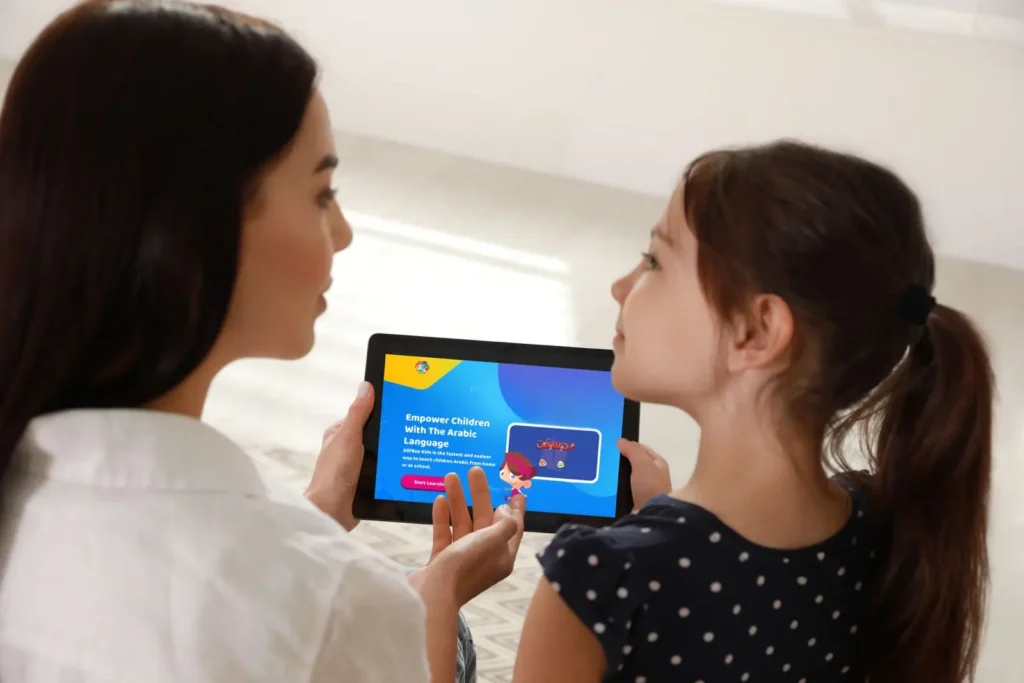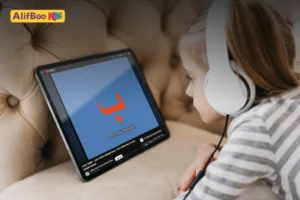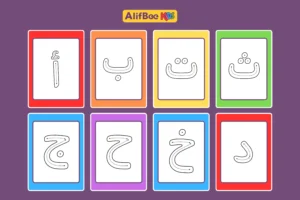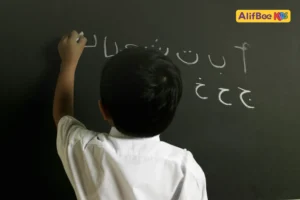Arabic learning for kids may seem like a challenging mission. Every language-learning method has its pros and cons. Learning through books, for example, can limit the development of listening and speaking skills. On the other hand, learning by listening to a teacher can greatly help with pronunciation and speaking but may not be as effective for reading and writing.
Arabic learning apps solve a large part of this problem by offering an easily accessible solution that keeps kids engaged while providing a comprehensive learning experience.
In this blog post, we’ll suggest excellent free and paid applications that can help your child practice the Arabic language from the comfort of their home.
Why Choose Apps to Learn Arabic for Kids?
If you want your children to learn Arabic effectively, it’s best to start early. As the Arabic proverb says, “Knowledge in childhood is like engraving on stone.”
With today’s technological advancements and children’s familiarity with digital devices, parents can make the most of the time kids spend on screens. By offering them the best Arabic learning apps, you can give your children the opportunity to learn the language of the Qur’an and enjoy its rich culture, arts, and music—all through engaging, interactive tools.
Best Free Arabic Learning Apps for Kids
Using a free app to learn Arabic is a great way to test the waters. You can start introducing your child to the Arabic language with one of these apps without breaking the bank or feeling like this step is a financial burden.
1. Duolingo
Duolingo is one of those apps that keeps both kids and adults coming back for more because of its achievement-based rewards! It uses a holistic approach to teach Arabic by training all four basic skills: reading, writing, listening, and speaking—for free. It is best suited for kids above 6 years old.
2. Siraj
Siraj is a simple application with gentle animations that keep kids engaged without overstimulation. It’s a great choice for early learners starting from age 4, as it includes exercises as simple as tracing.
3. Write It! Arabic
Apps like Write It! are ideal for kids who have zero knowledge of the language. It even works well for parents who are not familiar with Arabic. It focuses on the alphabet, teaching kids how to write the letters and pronounce them correctly.
Top Paid Apps to Learn Arabic for Kids

You may hesitate to pay for an app when so many free options exist. However, paid apps can be one of the best investments for teaching your child Arabic. These apps often provide structured curricula, offline access, and even cultural immersion that brings your child closer to the heart of the language.
1. AlifBee Kids
AlifBee Kids is great for beginners and kids who get bored easily. It takes children on a fun journey through interactive games that deliver information effectively without becoming repetitive. Its structured learning path allows parents to monitor their child’s progress closely.
2. Lamsa
Lamsa is a fun, educational app that entertains your child in a productive way. It’s not limited to Arabic learning but also includes English and Mathematics, making it a comprehensive learning platform.
3. Learn Arabic Alphabet Now
This app is ideal for absolute beginners whose parents don’t speak Arabic and haven’t yet introduced screens to their kids. It avoids overstimulation and doesn’t rely on flashy characters or animation. Instead, it focuses on helping kids learn the Arabic alphabet in all its forms.
Top Apps for Arabic Reading Skills
1. I Read Arabic – Fun Learning
This app allows children to choose from a wide selection of stories. It tracks how long it takes the child to read each story and shows the number of pages and new vocabulary introduced in every text.
2. Hekayat Belaraby
This app saves you the time and money you would otherwise spend on buying over 500 Arabic storybooks. These stories are perfect for Muslim kids living abroad, helping them stay connected to their language, culture, and religion.
3. Arabic Stories
Arabic Stories is a simple app with a user-friendly interface. It features 60 stories, including traditional tales such as Juha.
Apps for Writing and Alphabet Learning
1. Abjad for Kids
Abjad for Kids is a paid app that focuses on teaching the Arabic alphabet through original songs. It also allows kids to trace letters to learn correct writing techniques.
2. Arabic 101 – Learn to Write
Arabic 101 takes your child’s Arabic writing skills from zero to hero. It has three modes: easy, normal, and freestyle. The easy mode allows tracing letters, the normal mode builds writing precision, and the freestyle mode lets older kids write independently. This app is suitable for both kids and adults.
3. Joode: Learn Arabic Alphabet
Joode shows the correct pronunciation of each Arabic word using English letters. It also allows kids to draw letters and listen to their pronunciation. It’s suitable for both kids and adults.
Best Apps for Speaking and Listening Practice
1. Pimsleur
Pimsleur follows an audio-based methodology and suits kids older than 10 years. It requires learners to listen closely for 30 minutes a day to improve comprehension. It uses spaced repetition for memorization and is available in Egyptian, Levantine, and Modern Standard Arabic.
2. Learn Arabic: Language Course
This app doesn’t teach isolated words or phrases but focuses on vocabulary in proper context. The audio quality is clear, and its speech recognition features are quite advanced.
3. Duolingo Max
While your child can practice listening and speaking with the free version of Duolingo, Duolingo Max offers video call features that elevate practice to a whole new level—making it well worth the upgrade.
How to Choose the Right Arabic Learning App for Your Child
There’s no single “best” Arabic learning app. The right choice depends on your child’s age, goals, and learning style. Start by assessing your child’s current fluency level. Then, consider how much screen time you’re comfortable allowing and what you hope to achieve.
Ask yourself:
- Is it for future travel plans?
- Do you want them to learn conversation or focus on Qur’an reading?
- Are you aiming for language learning only or also cultural immersion?
Knowing your goal helps you choose the app that best serves your purpose. Whatever your goal, remember that consistency is key in any language-learning journey. Balance fun with education—if your child feels like learning Arabic is just another daily lesson, they may lose interest faster than you expect.
FAQs
While some parents may prefer physical lessons for their structure, many apps combine structured curricula with catchy music, colorful characters, and engaging animation to keep children motivated and excited to learn.
The best time to start Arabic learning for kids is as early as 2 years old. At that age, you can introduce Arabic sounds and vocabulary to help your child become familiar with how the language looks and sounds.
Yes, apps can definitely help your kids become fluent in Arabic. Free apps are a good starting point, but upgrading to paid versions can provide structured curricula that strengthen all four language skills. These affordable apps not only save time and money but also make learning consistent and enjoyable through music, games, and repetition—keeping your child engaged every day.





